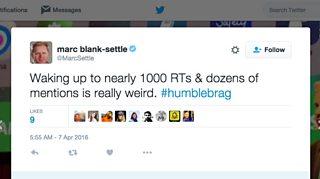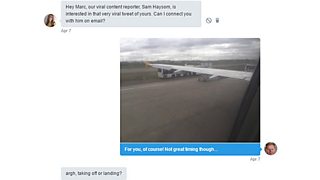What it's really like when your video goes viral
Marc Settle
specialises in smartphone reporting for the BBC Academy
This is the story of how I made a viral video with just two pieces of train track, and the lessons I learned from it about traffic-hungry news websites.

It all started so innocently. My two year old son Leo has an impressive collection of wooden train tracks. Once he’s in bed, I tidy up his playroom.
Usually I just put the train set away any old how, but this time I decided to stack the pieces of track neatly on top of one another. When the pile got too high I took the top curved piece off and put it on the table next to the main stack.
That was when I noticed something strange. The single piece looked longer than the others – even though I knew it wasn’t. I placed it back on top of the pile and, yes, it was the same length. I took it off again, placed it below the stack and it seemed longer again.
Being somewhat addicted to social media, the obvious thing to do was to film and share it. My personal experience of Twitter is that it has a “rhythm”: anything I tweet in the morning tends to do better than anything in the afternoon which does better than the evening. As I was tweeting this little video at 9.30pm, having added some suitably portentous music, I wasn’t expecting it to have much of an impact.
Pretty soon came the first take-away: the importance of influencers. One of the first people to retweet my video was Joanna Geary, an acquaintance in the social media world and now head of Twitter’s Moments team in the UK and Europe. She can spot something with viral potential, and soon her 21,000 or so followers had seen my video too.
Another early retweeter was Martin Belam of the Guardian, who also has a good number of socially-savvy followers.
Pleased with 150 retweets or so, I went to bed. An early start loomed as I was flying out of the country on holiday.

By early on Thursday morning, I was feeling real sympathy for those people who’ve been at the centre of a big news story and whose mentions would have been ten or a hundred times mine, often after a traumatic event, rather than a little video involving wooden train tracks.
The volume of tweets from strangers was astonishing. Initially I tried to be helpful and reply to each mention but I had to give up when that became impractical. Most of them were of the nature of “oh wow...that’s cool...my brain hurts” although a few were more along the lines of “how can you not know this...did you not do maths at school...you must be an idiot”. Again, my heart goes out to anyone who goes viral after expressing a controversial opinion on Twitter (we BBC employees aren’t allowed to have any opinions) as there’ll always be someone who’ll be quick to tell you you’re wrong and why, in no uncertain terms.
The first media request to use the video came via a Direct Message later that morning, in less than ideal circumstances.

I’ve known Blathnaid Healy, the UK editor of Mashable, for a few years now, so I was happy to help, even to the extent of tapping out a quick email about it all as we waited to take off. It soon formed the basis of a page on their site.
Of all the days to be out of contact for much of the day, it had to be this one. I genuinely wasn’t fleeing the country to avoid the attention. When we landed many hours later and I finally found connectivity, my eyes were opened up to the weird and wonderful workings of news sites in 2016.
Broadly, their behaviour fell in to one of three categories:
a) Journalists working for sites who tweeted me to ask to use my video in some form and to whom I said “yes”.
b) Those who tweeted me and to whom I didn’t reply for various reasons (more on this in a moment), who went ahead and used it anyway.
c) Those who didn’t even bother to ask and used it anyway.
And in a special category of their own, come on down Business Insider.
When the mentions are coming thick and fast, it’s hard to keep up and spot them all – especially when you’re meant to be on holiday with a toddler to entertain. Looking back through the replies I sent, the only sites which had my explicit permission to use the video in some form were:
- Mashable
- Vanity Fair Italy
- WSYX in Columbus Ohio
- Netmums
- El Pais
A pleasingly eclectic bunch, I think you’ll agree.
In category B, we find:
- The Daily Telegraph
- The BBC
- Metro
- Buzzfeed
- Mail Online
- Daily Mirror
- The Huffington Post
- WSPA North Carolina
- Essential Kids Australia
Had I seen the BBC request, it would have been hard not to say yes and clearly I don’t mind my employer using it. It’s done pretty well on the BBC too: two and a half million views via Facebook, a million hits on BBC Trending. But I can’t put my hand on my heart and say I would have given the green light to all the others in category B.
The list of those in category C is a lot longer. They included:
- The Irish Examiner
- ABC13 News
- The Independent
- 7 News Australia
- Slate
- Radio Times
- Good Housekeeping
- BoredomTherapy.com
- AOL
- The Daily Express
- Distractify
- Unexplained-mysteries.com
- Aol.com
- Yournewswire.com
- Liberalamerica.org
- Today.com
- The science world
- The poke.co.uk
Just Google “train track illusion” and you’ll find scores more. If this is what websites do with something trivial and ephemeral, imagine what they’ll do with breaking news videos when time is of the essence.
And, in fairness, this was shareable, but ultimately hardly life and death. That was why I was initially happy to give sites permission; I didn’t want to seem precious – especially when I subsequently found out this was an established optical illusion more than 100 years old.
That was also why I didn’t watermark the video with my name, as some have suggested I should have – which is ironic, as during the training I deliver for the BBC Academy, I teach my students how to watermark a video and to think about doing so. My reason for not watermarking it was simple: I genuinely didn’t think this video would do that well so it didn’t seem necessary. How vain will it seem if I now slap ©Marc Settle on every video I share on social media from now on?
What irked me was the vast number of sites which used my video without even the common courtesy to ask permission. They were getting good traffic and therefore revenue off the back of it. Yes, it’s possible that some had reciprocal agreements with sites to whom I had given my approval, but I’d bet that very few had.
If I hadn’t been on holiday, I would have made it my business to contact those sites and present a retrospective invoice for breach of copyright. However, they have lawyers and large legal departments and I probably would have received the brush-off – if they even bothered to reply. Away from home, I was unable to contact the miscreant sites effectively and unable to stop still others taking advantage of my video.
I’ve hovered on the edges of social media circles for a good few years now, so I’ve long been aware of a number of sites which can centralise this process – for a fee. Storyful contacted me quite early on as this all developed, as did NewsFlare; had I been at work, I might have been more switched on and willing to use their services sooner. Nearly 24 hours after Storyful’s initial contact, I agreed that they could manage the video, meaning that anyone wanting to use it should from then on go via them – “should” being the operative word. Additionally, they would contact unauthorised users for payment on my behalf. In return, they’d split the proceeds with me 60:40 (60 to me, that is).
Was it right to try to monetise (a word which seems less loaded than “make money from”) a trivial and ephemeral video? I would argue that it was: the traffic, clicks and resultant revenue these sites were getting were not through any hard work of an employee or freelancer. Many sites had no doubt just thought “oh this will do well, we’ll have that” and hang the niceties. That just didn’t seem right. Being aware of Storyful and the like, I’m probably in the minority. For others caught up in this sort of thing, to be contacted by a third party offering to manage and monetise a video must be bewildering, even scary.
It turns out I had stumbled across the Jastrow Illusion, first described by the American psychologist Joseph Jastrow late in the 19th century. So it was hardly something unique that others could be prevented from replicating. Indeed, I found that a number of videos also using train tracks had been uploaded to YouTube several years ago. In the last few weeks, at least two dozen more have also appeared, some mere “scrapes” of my video with scant attribution.
The best (or worst) example was Business Insider. Their reporter contacted me but only after Storyful had got involved and so I directed him to them. Rather than doing that, Business Insider (with full marks for chutzpah) made their own version of the video, titled it “this train track illusion is driving the internet insane”, added a short explanation and ran it on their sites where it has received more than 300,000 views, ten times more than my "original" one.
What conclusions can be drawn from this experience?
Firstly, precious few of the astonishing number of traffic-hungry websites out there seem to acknowledge or abide by any rules, conventions or laws relating to copyrighted material in the race to publish.
Secondly, the requests sent to an individual at the centre of a news-story are over-whelming and draining. The issue was discussed at the International Festival of Journalism 2016. The Online News Association offers guidance in the form of a “social newsgathering ethics code”, setting out standards that journalists ought to adhere to in terms of both verification and rights issues. It’s pleasing to see the BBC, the Guardian, CNN, Storyful and others supporting this initiative, but the number of news sites missing from the list is itself instructive.
Thirdly, having an agency like Storyful manage a viral video can be useful. As with many experiences in life, paying for the services of professionals who deal on a daily basis with the matter in question can be preferable to attempting to sort it all out yourself.
I don’t anticipate going viral again any time soon – but then I didn’t anticipate going viral this time around. With a two and a half year old toddler, the next time anything viral happens to him, I expect it to be chicken pox.
Our other blogs by Marc Settle
